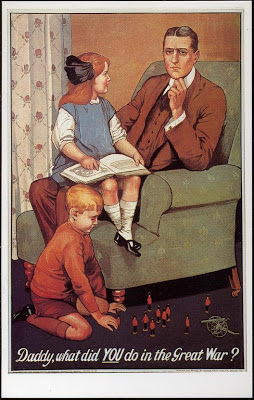- World peace & war
- An advertisement for an oven
- Independence day
- Patriotic
- Celebrating
- Exports
- Trades
- Wild west fonts
- Everyone looking at sam
- Slavery
- America saving the world
- Undermining other cultures food
- Aimed at men (women didn't have money to buy an oven.)
- Alpha male (farther)
- Girl looking at her farther in admiration
- You couldn't be forced into joining the army
- The farther wanting to be the childs role model
- The font is personal to the readers choice
- 1915 - after ww1
- Very british
- Focussed on the farther
- Propaganda
- Type stands out
- Traditional
- They look well off higher class
- Serious expression
Two images in comparison
- Patriotic
- Strongly portray the American/British cultures - reflective of cultural differences?
- Aspirational lifestyles
- The choice and organisation of font and style of illustration
- The purpose and meaning of the image
- The target/potential audience of the image
- The social and historical contexts relevant to the production of the image
Analysis:-
The first, and most obvious feature that these two posters
have in common is their purpose. Both posters aim to persuade the audience, but
use contrasting techniques to sell their message.
The ‘Uncle Sam’s
Range’ poster’s aim is to sell a materialistic item, making the reader believe
that the need it to live the rich, free and independent American life style
that is so often talked about. The first way in which it does this is through
the use of the Uncle Sam, a patriotic and symbolic figure of the greatness of
America, the eagle is also a sign of patriotism. An over whelming use of the
colours red white and blue hold further connotations of this. Patriotism
follows through with a slightly racist and egotistical view that America is the
most superior country in the world. Such as the list of food, showing
generalisations that all Irish people eat is potatoes, but intern boasting the
wide range of dishes that you will be able to cook. Likewise the world war one
poster also tries to convey its message through patriotism. The poster denotes
a well off looking man, surrounded by his young family. This poster differs
from the first as it is using emotion and empathy to sell its message. There
are how ever some glaringly obvious signs of patriotism here, such as the rose
curtains (roses are the flower of England). The young boy is also playing with
toy soldiers, this intern shows his father as a heroic figure that young
children look up to. The type at the bottom of the page almost acts as a
rhetorical question. The fathers reading the poster will apply the question to
their own life and imagine what it would be like if their own children saw them
as a heroic and brave soldier.
Both posters in my opinion are targeted at the same
audience; Middle class, working men. At the time period of both of these
posters men were seen as the providers of the household, women were inferior to
the superiority and power that men of the time held. This gender inequality is
echoed through the use of imagery in the ‘Uncle Sam’ poster, as it is a woman
serving the food and men sitting at the table. At first I thought it was
strange to aim a product that would most probably be used solely by women at a
male target audience. But then I realised that as women were seen as inferior
they probably wouldn’t have been able to make such a purchase, or even suggest
it. Again in the world war poster, women would not have been able to join the
army, so its only audience would be men.
There is a strong sense of greatness and achievement in both
posters. From my research I found out that the world war poster was produced a
year in to the war. The fact that the poster is in the future of a man and his
young family connotes that the war was triumphant and all soldiers returned
home unharmed. I think this was done for a number of reasons. Firstly because
it is good to keep positive during times of crisis and secondly because of a slightly
arrogant view that England is the greatest country and our men would conquer.
Over all I think there are lots of similarities and
difference of each poster. Both aim to sell ideologies and concepts, almost
trying to brainwash the audience. However the imagery is very different but
works to the same effect.


No comments:
Post a Comment